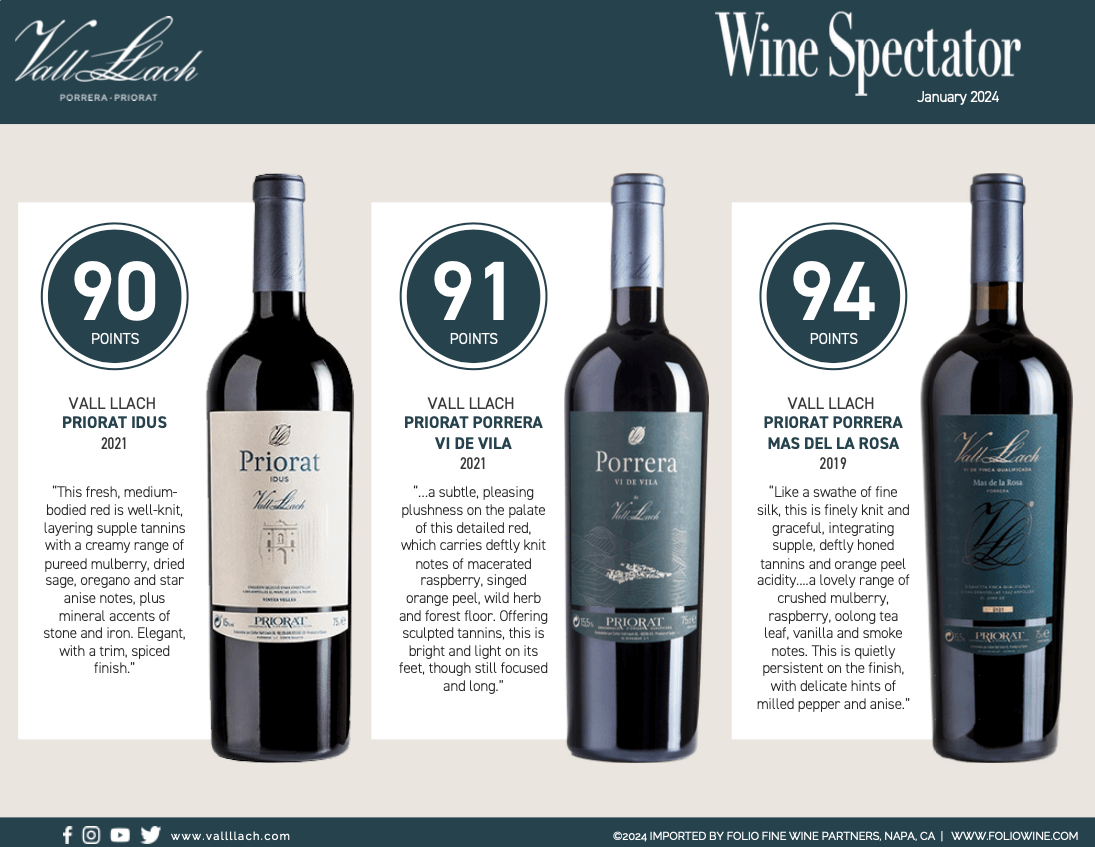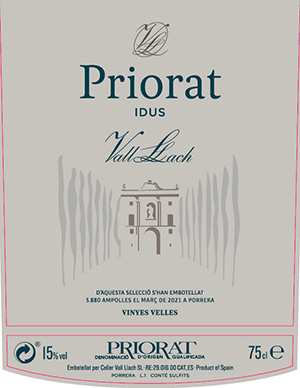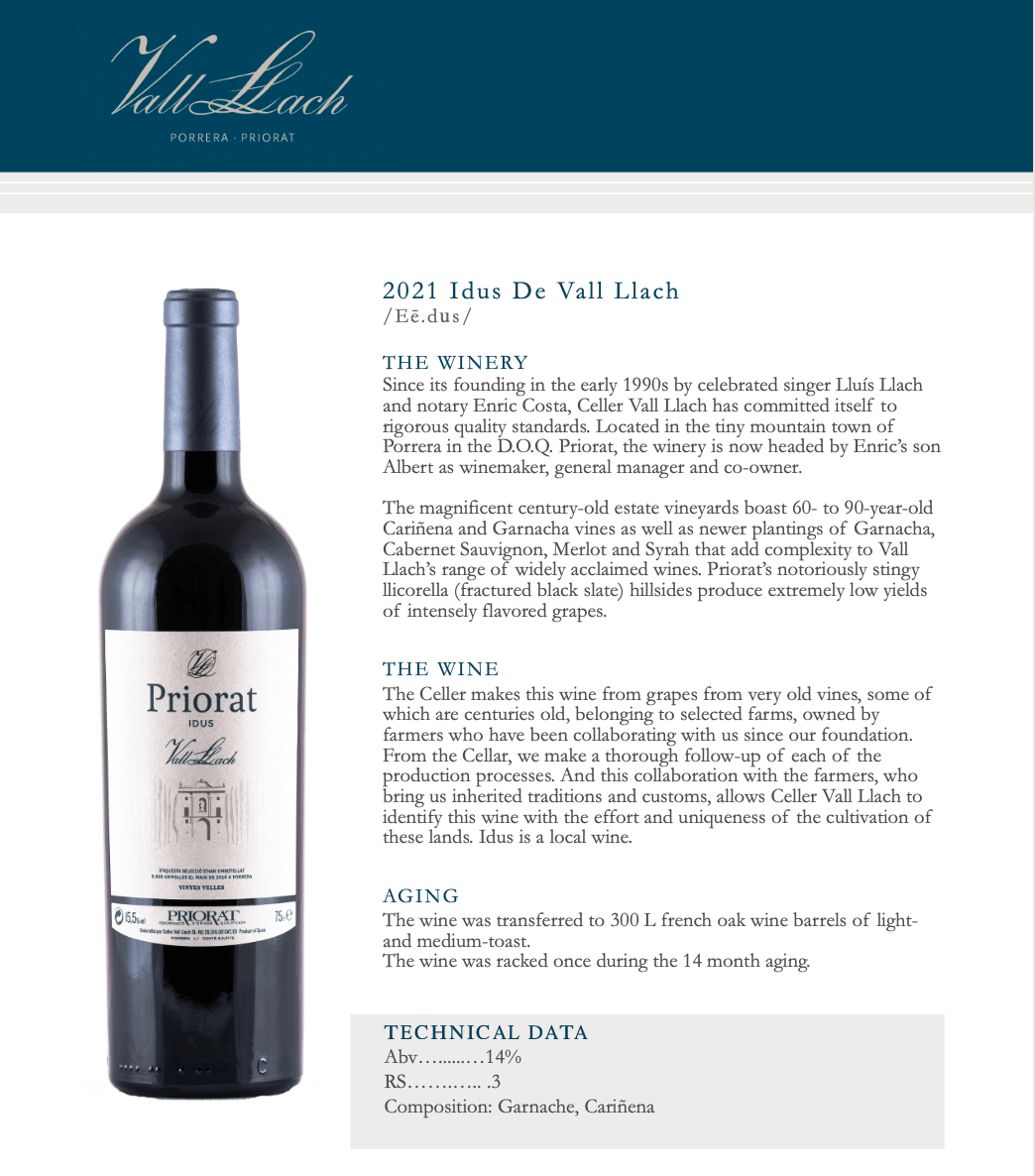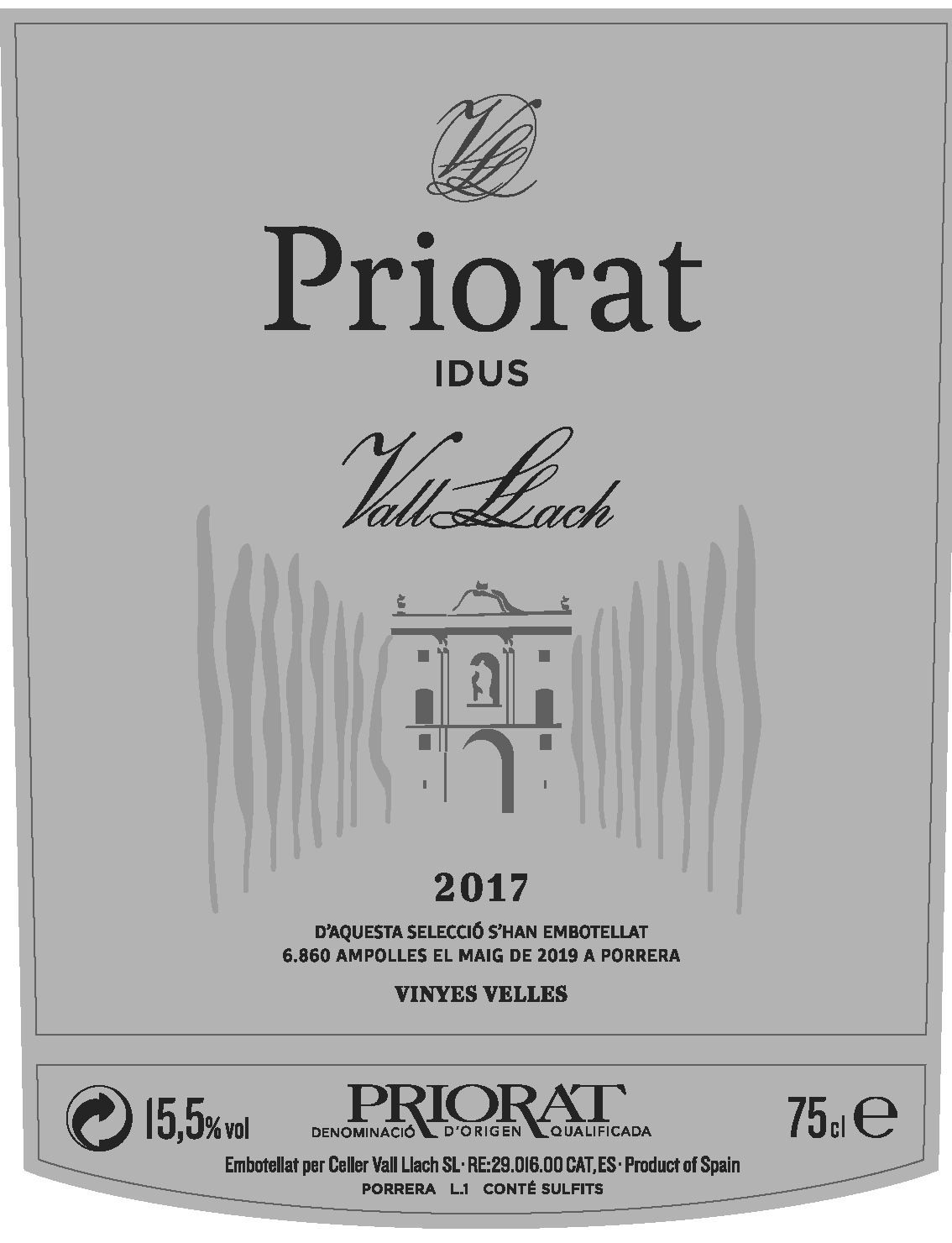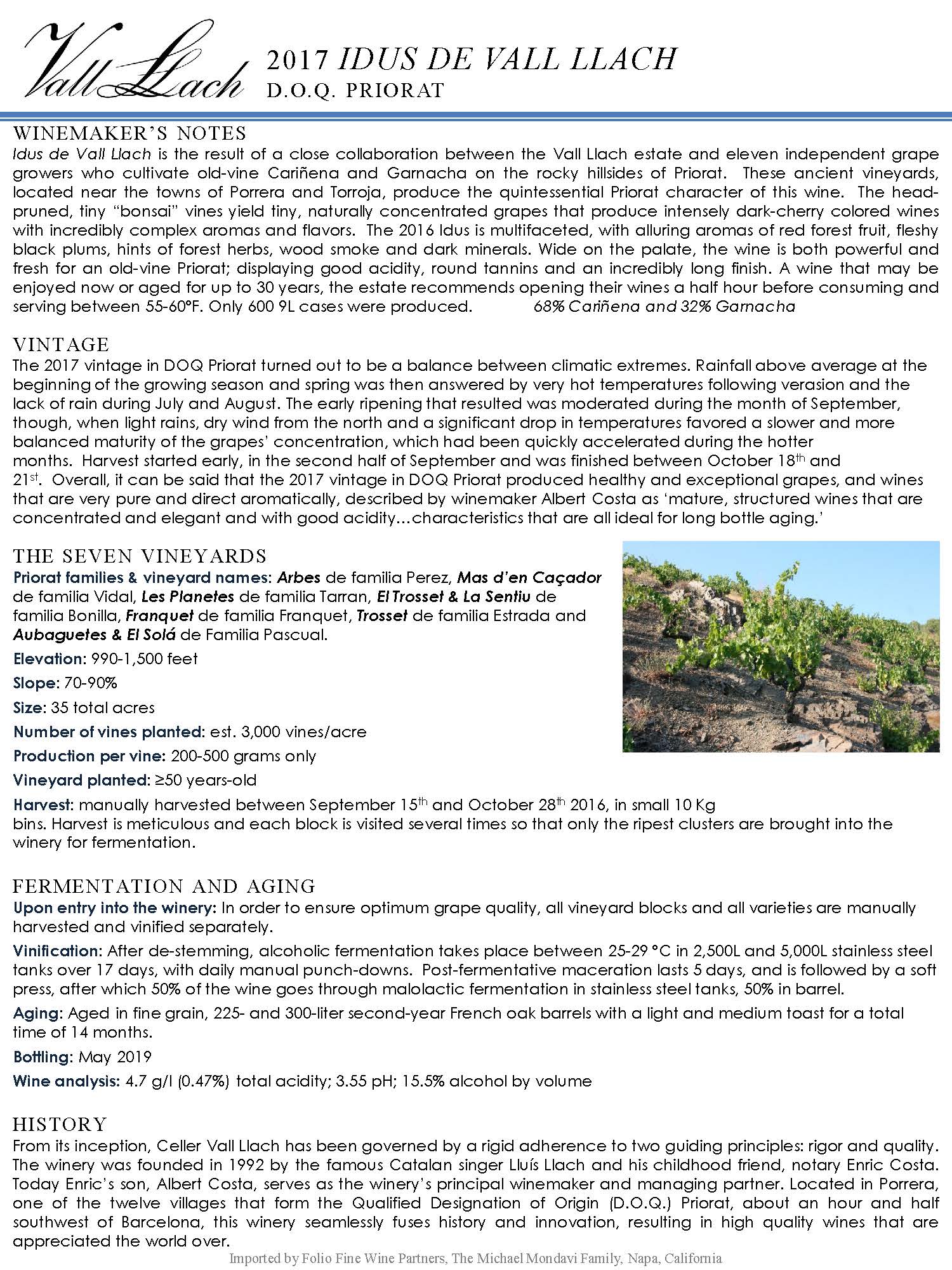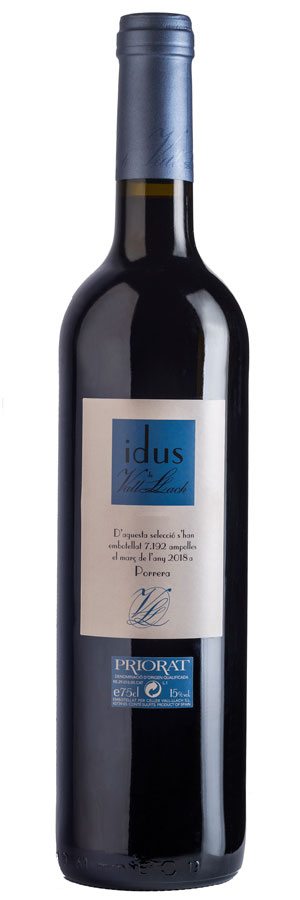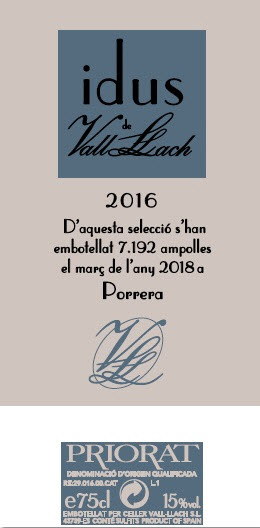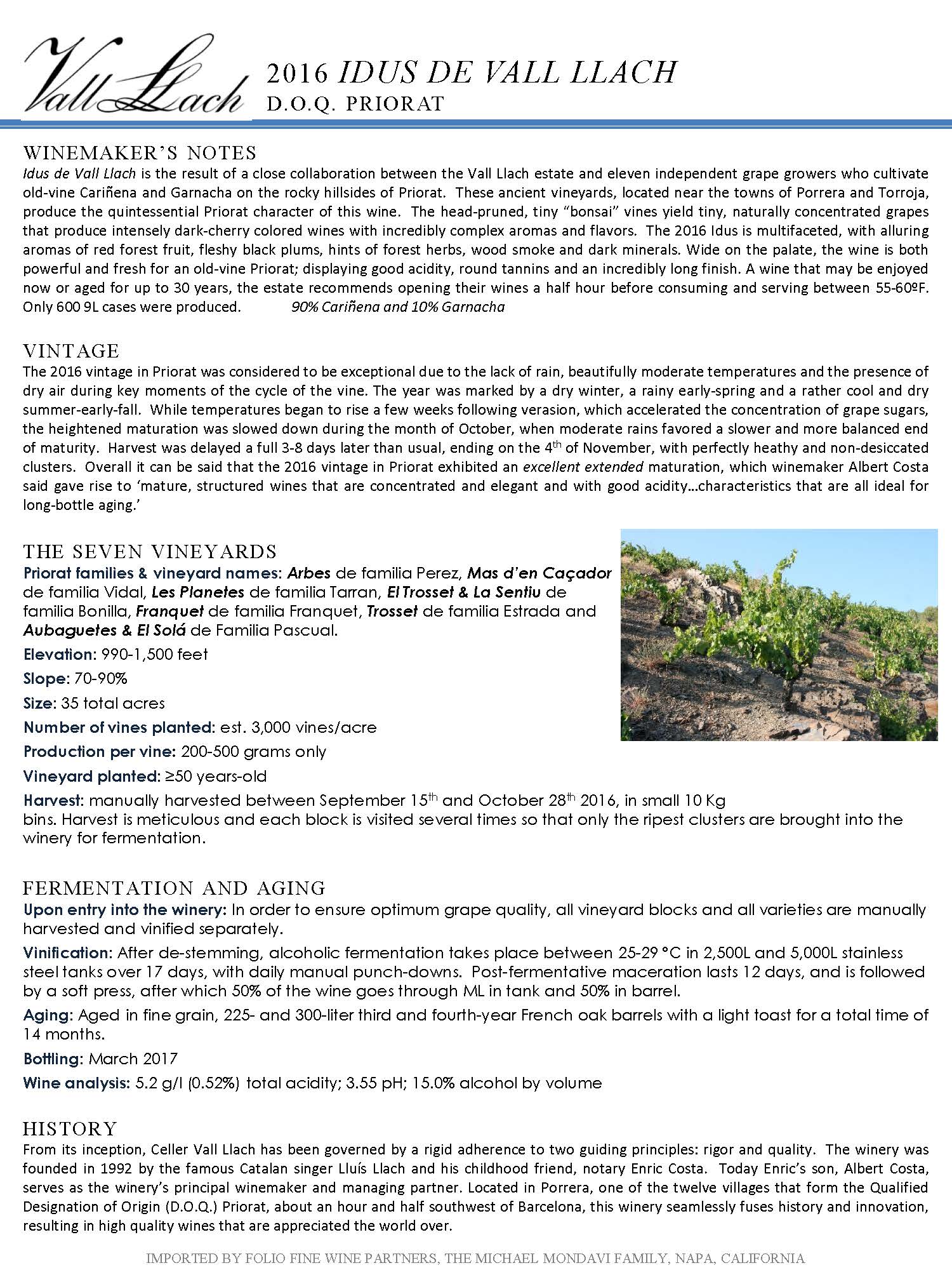



Idus de Vall Llach
DOQ Priorat, Spain
Tasting Notes
The head-pruned, tiny “bonsai” vines yield tiny, naturally concentrated grapes that produce an inky red wine with incredibly complex aromas and flavors. An elegant and modern wine, soft mineral tones are produced by the Cariñena vines that are balanced and structured by the inclusion of old-vine Garnacha.
Winemaking Notes
The wine was transferred to 300 L french oak wine barrels of light- and medium-toast. The wine was racked once during the 14 month aging.
Vineyard Notes
The magnificent century-old estate vineyards boast 60- to 90-year-old Cariñena and Garnacha vines as well as newer plantings of Garnacha, Cabernet Sauvignon, Merlot and Syrah that add complexity to Vall Llach’s range of widely acclaimed wines. Priorat’s notoriously stingy llicorella (fractured black slate) hillsides produce extremely low yields of intensely flavored grapes.
Technical Info
Varietals: Garnache, Cariñena
Alcohol Volume: 14%
RS: 0.3
Tasting Notes
The head-pruned, tiny “bonsai” vines yield tiny, naturally concentrated grapes that produce an inky red wine with incredibly complex aromas and flavors. An elegant and modern wine, soft mineral tones are produced by the Cariñena vines that are balanced and structured by the inclusion of old-vine Garnacha.
Harvest Notes
The wine was transferred to 225 and 300 litre second wine barrels of light- and medium-toasted fine grained new French oak. The wine was moved once during the ageing period of 14 months.
Winemaking Notes
The wine was transferred to 225 and 300 litre second wine barrels of light- and medium-toasted fine grained new French oak. The wine was moved once during the ageing period of 14 months.
Technical Info
3.57 pH 15.0% alcohol by volume
Tasting Notes
The head-pruned, tiny “bonsai” vines yield tiny, naturally concentrated grapes that produce an inky red wine with incredibly complex aromas and flavors. An elegant and modern wine, soft mineral tones are produced by the Cariñena vines that are balanced and structured by the inclusion of old-vine Garnacha. The 2017 Idus is multifaceted, with alluring aromas of red forest fruit, fleshy black plums, hints of forest herbs, wood smoke and dark minerals. Wide on the palate, the wine is both powerful and fresh for an old-vine Priorat; displaying good acidity, round tannins and an incredibly long finish.
Vintage Notes
The 2017 vintage in DOQ Priorat turned out to be a balance between climatic extremes. Rainfall above average at the beginning of the growing season and spring was then answered by very hot temperatures following verasion and the lack of rain during July and August. The early ripening that resulted was moderated during the month of September, though, when light rains, dry wind from the north and a significant drop in temperatures favored a slower and more balanced maturity of the grapes’ concentration, which had been quickly accelerated during the hotter months.Harvest started early, in the second half of September and was finished between October 18th and 21st.Overall, it can be said that the 2017 vintage in DOQ Priorat produced healthy and exceptional grapes, and wines that are very pure and direct aromatically, described by winemaker Albert Costa as ‘mature, structured wines that are concentrated and elegant and with good acidity…characteristics that are all ideal for long bottle aging.’
Harvest Notes
Harvest: manually harvested between September 15th and October 21st 2018, in small 10 Kg bins. Harvest is meticulous and each block is visited several times so that only the ripest clusters are brought into the winery for fermentation.
Winemaking Notes
Upon entry into the winery: In order to ensure optimum grape quality, all vineyard blocks and all varieties are manually harvested and vinified separately. Vinification: After de-stemming, alcoholic fermentation takes place between 25-29 ºC in 2,500L and 5,000L stainless steel tanks over 17 days, with daily manual punch-downs. Post-fermentative maceration lasts 5 days, and is followed by a soft press, after which 50% of the wine goes through ML in stainless steel tank and 50% in barrel. Aging: Aged in fine grain, 225- and 300-liter second-year French oak barrels with a light toast for a total time of 14 months. Bottling: May 2019
Vineyard Notes
The old vines that make up this wine are located in areas with enviable conditions due to their picturesque surroundings, hours of sunshine and elevation above sea level. The incredibly rocky slopes are impressive to the eye, and prevent any kind of mechanical farming, mandating an intimate and exclusive relationship with the wine grower. Celler Vall Llach counts on the enthusiastic collaboration of growers that own trossos, or fine old vineyard blocks, who during some very difficult years, continued to cultivate the traditional Cariñena and Garnacha grape varieties. Selected each year from the best old vineyard blocks that surround the emblematic village of Porrera, these ancient vines define the character of Idus de Vall Llach. A slow, manual harvest took place between September 15th and October 21st, where some of the best naturally-concentrated fruit found growing on the eastern side of Priorat was collected for making this singular wine.
Technical Info
Blend is 90% Cariñena, 10% Garnacha 5.2 g/l (0.52%) total acidity 3.55 pH 15.0% alcohol by volume
Tasting Notes
The head-pruned, tiny “bonsai” vines yield tiny, naturally concentrated grapes that produce an inky red wine with incredibly complex aromas and flavors. An elegant and modern wine, soft mineral tones are produced by the Cariñena vines that are balanced and structured by the inclusion of old-vine Garnacha. The 2016 Idus is multifaceted, with alluring aromas of red forest fruit, fleshy black plums, hints of forest herbs, wood smoke and dark minerals. Wide on the palate, the wine is both powerful and fresh for an old-vine Priorat; displaying good acidity, round tannins and an incredibly long finish.
Vintage Notes
The 2016 vintage in Priorat was considered to be exceptional due to the lack of rain, beautifully moderate temperatures and the presence of dry air during key moments of the cycle of the vine. The year was marked by a dry winter, a rainy early-spring and a rather cool and dry summer-early-fall. While temperatures began to rise a few weeks following verasion, which accelerated the concentration of grape sugars, the heightened maturation was slowed down during the month of October, when moderate rains favored a slower and more balanced end of maturity. Harvest was delayed a full 3-8 days later than usual, ending on the 4th of November, with perfectly healthy and non-desiccated clusters. Overall it can be said that the 2016 vintage in Priorat exhibited an excellent extended maturation, which winemaker Albert Costa said gave rise to ‘mature, structured wines that are concentrated and elegant and with good acidity…characteristics that are all ideal for long-bottle aging.’
Harvest Notes
Harvest: manually harvested between September 15th and October 28th 2016, in small 10 Kg bins. Harvest is meticulous and each block is visited several times so that only the ripest clusters are brought into the winery for fermentation.
Winemaking Notes
Upon entry into the winery: In order to ensure optimum grape quality, all vineyard blocks and all varieties are manually harvested and vinified separately. Vinification: After de-stemming, alcoholic fermentation takes place between 25-29 ºC in 2,500L and 5,000L stainless steel tanks over 17 days, with daily manual punch-downs. Post-fermentative maceration lasts 12 days, and is followed by a soft press, after which 50% of the wine goes through ML in tank and 50% in barrel. Aging: Aged in fine grain, 225- and 300-liter third and fourth-year French oak barrels with a light toast for a total time of 14 months. Bottling: March 2017
Vineyard Notes
The old vines that make up this wine are located in areas with enviable conditions due to their picturesque surroundings, hours of sunshine and elevation above sea level. The incredibly rocky slopes are impressive to the eye, and prevent any kind of mechanical farming, mandating an intimate and exclusive relationship with the wine grower. Celler Vall Llach counts on the enthusiastic collaboration of growers that own trossos, or fine old vineyard blocks, who during some very difficult years, continued to cultivate the traditional Cariñena and Garnacha grape varieties. Selected each year from the best old vineyard blocks that surround the emblematic village of Porrera, these ancient vines define the character of Idus de Vall Llach. A slow, manual harvest took place between September 15th and October 28th, where some of the best naturally-concentrated fruit found growing on the eastern side of Priorat was collected for making this singular wine.
Technical Info
Blend is 90% Cariñena, 10% Garnacha 5.2 g/l (0.52%) total acidity 3.55 pH 15.0% alcohol by volume
 Back To Menu
Back To Menu

